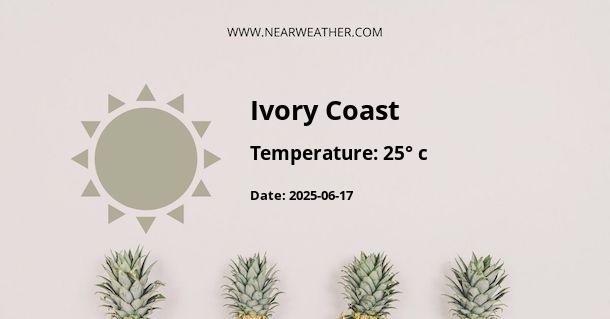The Climate and Weather of the Republic of Côte d’Ivoire, CI
The Republic of Côte d’Ivoire, also known as Ivory Coast, is a country located in West Africa. It is known for its diverse landscapes, vibrant culture, and rich history. In order to truly appreciate and plan for a visit to this beautiful country, it is important to understand its climate and weather patterns throughout the year.
1. Geographical Factors
The climate of Côte d’Ivoire is influenced by several geographical factors. The country is located close to the equator, which means it experiences a tropical climate. Additionally, it is characterized by a coastline along the Atlantic Ocean to the south and borders several countries to the north, including Mali and Burkina Faso.
The country's geographical diversity plays a significant role in its climate variations. The southern part of Côte d’Ivoire is generally warmer and more humid, while the northern regions are drier and experience a savanna climate.
2. Seasons
Côte d’Ivoire experiences four distinct seasons: two wet seasons and two dry seasons.
“The country experiences a long wet season from May to July and a short wet season from October to November. The dry seasons occur from December to February and from June to August.”
During the wet seasons, the country receives a significant amount of rainfall, which contributes to the lush greenery and agricultural productivity. The dry seasons, on the other hand, have relatively lower rainfall and higher temperatures.
3. Temperature
The temperature in Côte d’Ivoire remains relatively high throughout the year due to its proximity to the equator. The average annual temperature ranges from 25°C to 32°C (77°F to 90°F) in the coastal regions and 22°C to 34°C (72°F to 93°F) in the interior regions.
The coastal areas experience cooler temperatures compared to the inland regions due to the moderating effect of the Atlantic Ocean. The highest temperatures are usually recorded during the dry season, particularly in the northern parts of the country.
4. Rainfall
Rainfall is an important aspect of Côte d’Ivoire's climate, especially for its agriculture-based economy. The country receives an average annual rainfall of 1,200 to 2,000 millimeters (47 to 79 inches), with variations across different regions.
The coastal regions experience higher rainfall, with the wettest months occurring during the long wet season from May to July. The northern regions receive less rainfall, and the short wet season from October to November is the period of greatest precipitation in those areas.
5. Harmattan Winds
Côte d’Ivoire is also affected by the Harmattan winds, which blow from the Sahara Desert in the north. These dry and dusty winds usually occur between November and February, and they can significantly reduce visibility and increase the dryness of the air.
The Harmattan winds can have an impact on the temperature by causing a slight drop during their occurrence. They also affect the agricultural sector and can lead to dryness and potential crop damage.
6. Regional Climate Variations
While Côte d’Ivoire has a relatively consistent climate throughout the country, there are regional variations due to its diverse topography. For instance, the mountainous areas in the west experience cooler temperatures compared to the coastal and northern regions.
Additionally, the country's proximity to the coast also results in a higher level of humidity in the southern regions, which can make the temperatures feel even warmer.
Conclusion
The Republic of Côte d’Ivoire has a tropical climate influenced by its geographical location and diverse topography. The country experiences two wet seasons and two dry seasons, with the wettest periods occurring from May to July and October to November. The average annual temperature ranges from 25°C to 32°C (77°F to 90°F) in the coastal regions and 22°C to 34°C (72°F to 93°F) in the inland areas. Rainfall varies across the country, with the coastal regions receiving higher amounts compared to the northern regions. The Harmattan winds from the Sahara Desert also affect the country, particularly between November and February. Understanding the climate and weather patterns of Côte d’Ivoire is essential for anyone planning to visit or engage in various economic activities within the country.
A - Ivory Coast's Latitude is 8.000000 & Longitude is -5.000000.
A - Weather in Ivory Coast is 27° today.
A - Climate Conditions in Ivory Coast shows overcast clouds today.
A - Humidity in Ivory Coast is 56% today.
A - Wind speed in Ivory Coast is 7.2 km/h, flowing at 125° wind direction. today.
